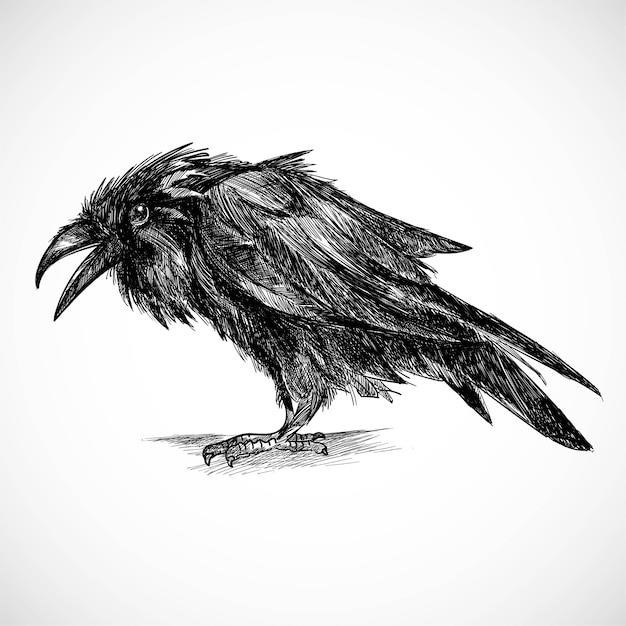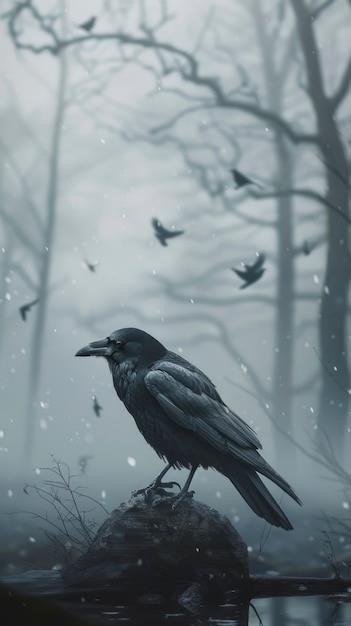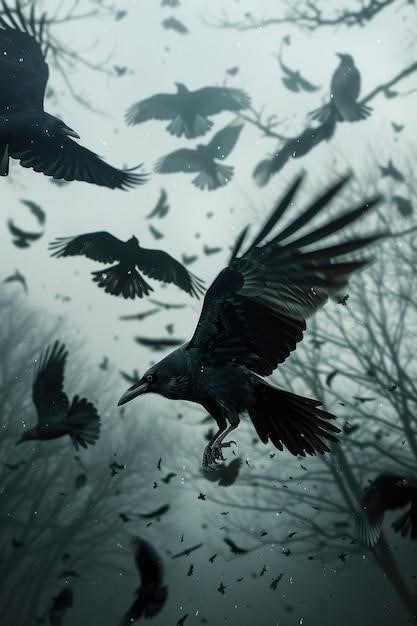Edgar Allan Poe’s “The Raven”⁚ A Deep Dive
Edgar Allan Poe’s “The Raven” is a narrative poem that has captivated readers for generations with its haunting atmosphere, lyrical language, and exploration of grief and loss. Published in 1845, the poem tells the story of a grieving speaker who is visited by a raven on a bleak December night. The raven’s enigmatic response of “Nevermore” to the speaker’s questions about his lost love, Lenore, amplifies the speaker’s despair and plunges him into a vortex of madness. “The Raven” is a masterpiece of Gothic literature, known for its intricate rhythm and sound devices, as well as its enduring themes of love, death, and the supernatural.
The Poem’s Genesis and Popularity

The genesis of “The Raven” can be traced back to Poe’s own personal struggles and his fascination with the macabre. In 1844, Poe was experiencing a period of intense grief following the loss of his beloved wife, Virginia. This profound sorrow is believed to have fueled the poem’s melancholic tone and its exploration of themes of love, death, and despair. Poe’s meticulous approach to writing is evident in his essay “The Philosophy of Composition,” where he outlines the deliberate choices he made in crafting “The Raven,” including the selection of the raven as a symbol of ill omen and the haunting refrain of “Nevermore.” The poem’s popularity was immediate and widespread. It was published in January 1845 in the New York Evening Mirror, and within a short time, multiple reprints and illustrated versions were released. “The Raven” quickly became one of Poe’s most celebrated works, solidifying his reputation as a master of the macabre and a poet of profound emotional depth. The poem’s enduring appeal lies in its ability to tap into universal human experiences of loss, grief, and the search for meaning in the face of mortality.
“The Raven” as a Gothic Masterpiece
Edgar Allan Poe’s “The Raven” stands as a quintessential example of Gothic literature, embodying the genre’s characteristic elements of darkness, mystery, and psychological exploration. The poem’s setting is a stark and atmospheric one⁚ a solitary chamber in a decaying mansion, where the speaker is consumed by grief and tormented by the raven’s presence. Poe skillfully employs imagery that evokes a sense of dread and unease, from the “bleak December” night to the “grim, ungainly, ghastly, gaunt, and ominous bird” that enters the chamber. The poem’s exploration of the speaker’s descent into madness and his obsession with the raven’s cryptic pronouncements reflects the Gothic preoccupation with the darker aspects of human nature and the unsettling power of the supernatural. “The Raven” exemplifies the Gothic genre’s ability to tap into primal fears and anxieties, creating a chilling and unforgettable reading experience.
Themes of Grief, Loss, and the Supernatural
At its core, “The Raven” is a poem about the profound pain of loss and the struggle to cope with grief. The speaker’s deep sorrow over the death of his beloved Lenore permeates the poem, creating a palpable atmosphere of melancholy and despair. The raven, with its ominous presence and its single, haunting refrain of “Nevermore,” acts as a catalyst for the speaker’s emotional unraveling, amplifying his despair and forcing him to confront the permanence of loss. The poem’s exploration of grief transcends the personal, delving into universal themes of mortality and the fragility of human happiness. The supernatural element, embodied by the raven, serves as a powerful symbol of the speaker’s internal turmoil and the dark forces that can consume the human psyche. “The Raven” offers a chillingly honest portrayal of grief’s power to warp reality and drive individuals to the brink of madness.
The Raven’s Symbolic Significance
The raven, beyond its literal presence, serves as a profound symbol within “The Raven.” It embodies the speaker’s grief and the relentless nature of his sorrow. The raven’s repetition of “Nevermore” acts as a cruel echo of the speaker’s own thoughts, amplifying his despair and reminding him of the impossibility of escaping his pain. The bird’s black plumage symbolizes the darkness that has consumed the speaker’s world, while its association with death further underscores the poem’s themes of loss and mortality. Furthermore, the raven’s intelligence and ability to speak, while limited to a single word, suggests a connection to the supernatural, hinting at a force beyond human comprehension that is actively manipulating the speaker’s fate. The raven, therefore, becomes a powerful manifestation of the speaker’s internal struggles and the overwhelming power of grief.
Poe’s Masterful Use of Rhythm and Sound
Poe’s “The Raven” is a testament to his mastery of rhythm and sound, creating a hypnotic and unforgettable auditory experience. The poem’s distinct rhythm, achieved through the use of trochaic octameter, lends a sense of urgency and intensity to the narrative, mimicking the speaker’s increasingly frantic state of mind. The regular beat, punctuated by the occasional trochaic tetrameter line, creates a hypnotic effect that draws the reader into the poem’s dark atmosphere. Poe’s skillful use of alliteration, assonance, and consonance further enhances the poem’s musicality. Words like “dreary,” “weak,” and “weary” in the opening lines create a sense of melancholy through repetition of consonant sounds. The frequent use of “o” and “e” sounds in phrases like “forgotten lore” and “chamber door” adds to the poem’s haunting quality, creating a sense of sorrow and longing.
The Haunting Refrain of “Nevermore”

The single word “Nevermore,” uttered by the raven, becomes the poem’s chilling refrain, echoing through the speaker’s mind and haunting the reader long after the final stanza. This simple yet powerful word serves as a constant reminder of the speaker’s loss and the futility of his attempts to escape his grief. It becomes a symbol of the permanence of death and the speaker’s inability to find solace or hope. The repetition of “Nevermore” creates a sense of relentless despair, emphasizing the speaker’s growing isolation and the bleakness of his future. The word’s dark and final tone reinforces the poem’s Gothic atmosphere, leaving a lasting impression of hopelessness and the enduring power of grief.
The Speaker’s Descent into Despair
The speaker’s initial encounter with the raven is marked by a mixture of curiosity and a desperate hope for some kind of solace. He questions the bird about his lost love, Lenore, seeking reassurance or a sign of her presence. However, the raven’s relentless repetition of “Nevermore” gradually crushes the speaker’s hope, leading him down a path of deepening despair. As the night progresses, the speaker’s questions become increasingly desperate and tinged with madness. The raven’s unchanging response serves as a stark reminder of the finality of death and the speaker’s inability to escape his grief. This descent into despair is evident in the speaker’s increasingly erratic behavior, his growing paranoia, and his eventual acceptance of his fate. By the poem’s end, the speaker has been irrevocably consumed by despair, leaving the reader with a chilling glimpse into the depths of human suffering.
The Poem’s Impact on Literature and Culture
“The Raven” has had a profound and lasting impact on literature and culture, solidifying Poe’s place as a literary icon. The poem’s unique blend of gothic imagery, lyrical language, and exploration of human emotions resonated with readers and critics alike, establishing Poe as a master of the macabre. The poem’s haunting refrain, “Nevermore,” has become synonymous with despair and the inevitability of death, entering the lexicon of popular culture. “The Raven” has been adapted into numerous films, television shows, and musical works, ensuring its continued relevance in contemporary art. Its influence can be seen in the works of countless writers and poets, inspiring a fascination with themes of loss, grief, and the supernatural. Even today, “The Raven” remains a powerful testament to Poe’s genius, continuing to captivate and challenge readers with its enduring themes and masterful artistry.
“The Raven” as a Work of the Romantic Era
“The Raven” is a quintessential work of the Romantic era, a period characterized by an emphasis on emotion, imagination, and the individual experience. Poe’s poem embodies these Romantic ideals through its exploration of the speaker’s intense grief and yearning for his lost love, Lenore. The poem’s focus on the speaker’s internal world and his emotional journey is a hallmark of Romantic literature. The supernatural element of the raven, a symbol of the speaker’s despair, further aligns with the Romantic fascination with the mysterious and the unknown. Poe’s use of vivid imagery, lyrical language, and evocative sound devices also contribute to the poem’s Romantic sensibility, creating a rich and immersive sensory experience for the reader. Through its exploration of emotion, imagination, and the supernatural, “The Raven” stands as a powerful testament to the enduring legacy of the Romantic era.
Edgar Allan Poe⁚ A Literary Icon
Edgar Allan Poe’s legacy as a literary icon is deeply intertwined with “The Raven.” The poem’s immense popularity upon its publication catapulted Poe to literary fame, solidifying his status as a master of the macabre and a pioneer of the Gothic genre. “The Raven” became synonymous with Poe’s name, showcasing his mastery of language, rhythm, and atmosphere. His exploration of dark themes, psychological torment, and the supernatural resonated deeply with audiences, establishing him as a leading figure in American literature. Beyond “The Raven,” Poe’s works, including his short stories and poems, continue to captivate readers with their haunting beauty, psychological depth, and enduring themes. His influence on subsequent generations of writers is undeniable, making him a literary icon whose works continue to be celebrated and analyzed today.
“The Raven” in Modern Adaptations
The enduring power of “The Raven” has inspired numerous modern adaptations across various media. The poem’s haunting imagery and themes have found new life in film, television, music, and even video games. From the 1935 film “The Raven,” starring Boris Karloff, to the 2012 film “The Raven,” starring John Cusack, Poe’s iconic tale continues to resonate with filmmakers. The poem’s iconic refrain, “Nevermore,” has been used in countless songs, from rock anthems to classical compositions, showcasing its enduring impact on popular culture. Video games like “The Raven” (2005) and “The Raven⁚ Legacy of the Master Thief” (2013) have also incorporated elements of Poe’s poem, drawing on its suspenseful atmosphere and enigmatic characters. These adaptations demonstrate the enduring relevance of “The Raven” in modern storytelling and its ability to transcend time and genre.
The Enduring Legacy of “The Raven”
“The Raven” has left an indelible mark on literary history and popular culture, solidifying Edgar Allan Poe’s status as a literary icon. Its influence can be seen in countless works of literature, music, film, and art. The poem’s haunting atmosphere, unforgettable refrain, and exploration of grief and loss have resonated with audiences for generations. Its themes of love, death, and the supernatural continue to hold a powerful grip on the human imagination. The poem’s iconic imagery, such as the raven, the bust of Pallas, and the speaker’s chamber, have become part of the collective consciousness, appearing in everything from book covers to tattoos. “The Raven” remains a testament to Poe’s genius and his enduring legacy as a master of the macabre and a profound explorer of the human condition.
